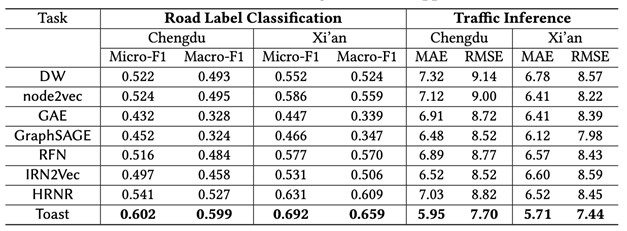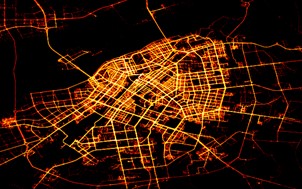Robust Road Network Representation Learning: When Traffic Patterns Meet Traveling Semantics
- Novel method to learn generic road network representations for various downstream applications
Road network is a fundamental yet indispensable component in transportation systems, and it plays an important role in various downstream applications, such as road attribute inference, travel time estimation, etc. Therefore, deriving effective representations that can capture intrinsic characteristics of the road network can directly boost the effectiveness of all these tasks.
Our proposed framework, named Toast, allows us to learn robust and generic representations for road networks to benefit various downstream applications. The key features of our approach include:
- Our method overcomes two non-trivial issues that prevent existing approaches from learning effective road network representations.
- Our method consists of two modules which capture multi-faced characteristics, namely traffic patterns and traveling semantics on road network.
- The effectiveness of the learned representations in both road-segment-based applications and trajectory-based applications is verified.
Previous work on graph representation learning fails to distinguish the unique features on road network: (1) road network doesn’t follow the assumptions of common graphs (e.g., homophily); (2) road network has feature uniformity properties in some regions. Instead, we enable the representation awareness of graph structure and traffic patterns by incorporating an auxiliary traffic context prediction objective to address the first issue, and utilize trajectory data to extract traveling semantics for indistinguishable road network fractions caused by the second issue.
 Figure1: Framework Overview
Figure1: Framework Overview
In the experiment, we tested the performance of Toast framework on two road-segment-based applications, including road label classification and traffic inference, with several baseline models published in previous papers.

Table1: Results on road-segment-based applications
Furthermore, we also tested the performance on two trajectory-based applications, including travel time estimation and trajectory similarity search.

Table 2: Results on trajectory-based applications
This framework can learn road network representations that can support more applications in transport systems, such as route inference, congestion detection, etc.

Yile Chen, Xiucheng Li, Gao Cong, Zhifeng Bao, Cheng Long, Yiding Liu, Arun Kumar Chandran, Richard Ellison. “Robust Road Network Representation Learning: When Traffic Patterns Meet Traveling Semantics.” In Proceedings of the 30th ACM International Conference on Information & Knowledge Management, 2021. (Link)
Email: [email protected]

